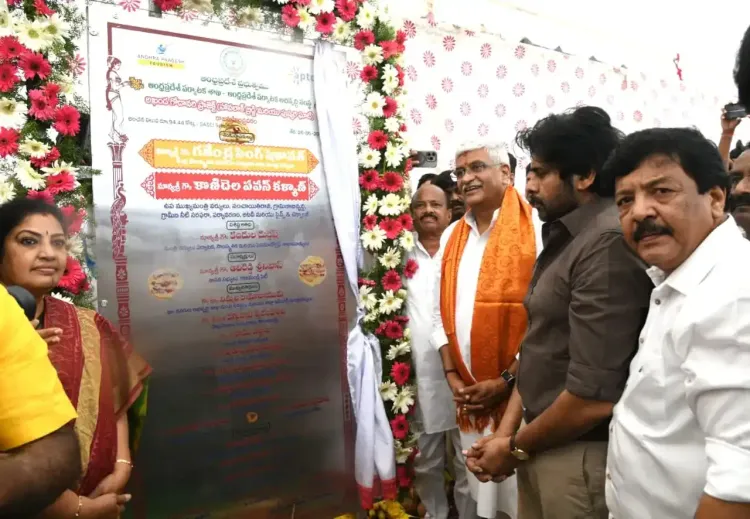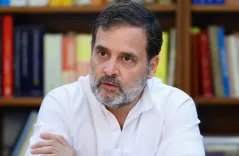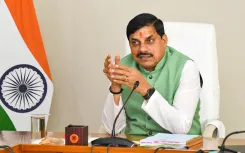What is the Akhanda Godavari Project in Andhra Pradesh?

Synopsis
Key Takeaways
- The Akhanda Godavari project aims to enhance heritage tourism in Andhra Pradesh.
- It has a budget of Rs. 94.44 crore.
- The project is expected to create 8,000 jobs.
- It targets attracting 35 lakh tourists by 2035.
- Key features include the revitalization of Havelock Bridge and development of Pushkar Ghat.
Amaravati, June 26 (NationPress) The foundation stone for the Akhanda Godavari project was laid by Union Minister for Tourism and Culture Gajendra Singh Shekhawat along the banks of the Godavari River in Rajamahendravaram, Andhra Pradesh on Wednesday.
During the ceremony, the Union Minister conducted bhumi puja for the ambitious Rs. 94.44 crore initiative in the presence of Andhra Pradesh Deputy Chief Minister K. Pawan Kalyan.
Shekhawat emphasized that this transformative cultural and tourism project is set to enhance heritage tourism, marking a new chapter for Godavari's spiritual and economic landscape.
The project, part of the Scheme for Special Assistance to States for Capital Investment (SASCI), aims to rejuvenate the historic Havelock Bridge, redevelop Pushkar Ghat, establish a Kadiyam Nursery Experience Centre, and improve pilgrim facilities in Nidadavolu.
According to Shekhawat, the initiative is expected to generate both direct and indirect employment for 8,000 individuals through the growth of local hotels, restaurants, transportation, and other sectors.
The Akhanda Godavari project aspires to draw 35 lakh tourists by 2035.
He also noted that seven tourism projects totaling Rs 450 crore have been approved for Andhra Pradesh.
On the request of the coalition government headed by Chief Minister N. Chandrababu Naidu, the foundation for numerous projects is being laid under the leadership of Prime Minister Narendra Modi.
Shekhawat commended the initiatives led by Chief Minister Naidu, Deputy CM Pawan Kalyan, State Tourism Minister Kandula Durgesh, and MP Purandeshwari in conceptualizing these projects.
The Central Minister highlighted the government's commitment to tourism development through various schemes such as Swadeshi Darshan, Prasad, SASCI, and Challenge-Based Destination Development (CBDD), with the aim of positioning India as a prime tourist destination.
He remarked that the Swadeshi Darshan Scheme has already provided support for sites like Kakinada Hope Island, Koringa Wildlife Sanctuary, Pulicat Lake, Maipadu Beach, as well as locations in the Buddhist Circuit including Shalihundam, Bavikonda, and Amaravati.
Additionally, Araku, Borra Caves, Lambasingi, and Suryalanka beaches are slated for development under Swadeshi Darshan 2.0.
Deputy CM Pawan Kalyan stated that progress is achievable with strong leadership, noting that the initiation of multiple projects in the state over the past year showcases the effectiveness of the double-engine government.
The Central Minister and Deputy CM also inaugurated the Regional Science Laboratory on the outskirts of Rajamahendravaram and performed bhumi puja for the permanent campus buildings of the Andhra Pradesh State Forest Academy in the Diwancheruvu Reserve Forest.
Tourism Minister Kandula Durgesh announced that forthcoming projects include the reconstruction of the Havelock Bridge, development of the Pushkara Ghats, continuous Harati performances for Godavari, and enhancements to the Kota Sathemma Talli temple at Nidadavolu.
Durgesh projected that the Akhanda Godavari project would be finalized by the time of Pushkaralu-2027, potentially attracting between 15 to 20 lakh pilgrims annually if the Pushkara ghats are developed.
He expressed that the project would bring a new allure to the Godavari’s catchment areas, with plans for 54 spans constructed over a length of 2.7 km.
Each span will showcase different themes, representing the rich history of Rajamahendravaram and Andhra Pradesh. The proposed plan includes the creation of waterfalls, glass bridges, gaming zones, space themes, urban craft bazaars, hanging gardens, hologram zoos, time travel exhibitions, rail museums, and aqua tunnels.





